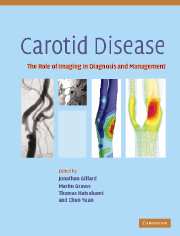Book contents
- Frontmatter
- Contents
- List of contributors
- List of abbreviations
- Introduction
- Background
- Luminal imaging techniques
- Morphological plaque imaging
- Functional plaque imaging
- Plaque modelling
- 23 The proximal carotid arteries – image-based computational modelling
- 24 Mechanical image analysis using finite element method
- Monitoring the local and distal effects of carotid interventions
- Monitoring pharmaceutical interventions
- Future directions in carotid plaque imaging
- Index
- References
24 - Mechanical image analysis using finite element method
from Plaque modelling
Published online by Cambridge University Press: 03 December 2009
- Frontmatter
- Contents
- List of contributors
- List of abbreviations
- Introduction
- Background
- Luminal imaging techniques
- Morphological plaque imaging
- Functional plaque imaging
- Plaque modelling
- 23 The proximal carotid arteries – image-based computational modelling
- 24 Mechanical image analysis using finite element method
- Monitoring the local and distal effects of carotid interventions
- Monitoring pharmaceutical interventions
- Future directions in carotid plaque imaging
- Index
- References
Summary
Introduction and general modeling considerations
Development in medical image technology has led to impressive progress in image-based computational modeling which adds a new dimension (mechanical analysis) to atherosclerostic plaque image analysis. While current patient screening and diagnosis are mainly based on 2D images and experiences from radiologists and physicians, plaque progression and rupture are believed to be related to plaque morphology, mechanical forces, vessel remodeling, blood conditions (cholesterol, sugar, etc.), chemical environment, and lumen surface conditions (inflammation) (Fuster et al., 1990; Fuster, 1998; Suri and Laxminarayan, 2003). The mechanisms governing plaque progression and causing plaque rupture are not fully understood. The motivations of using computational models to perform mechanical image analysis are based on the following:
(i) mechanical forces play an essential role in plaque progression and rupture. Plaque itself would not rupture if no forces were acting on it. Both mechanical forces and plaque structure are key factors in the progression and rupture process and should be examined together;
(ii) fluid-structure interaction (FSI) plays an essential role in plaque mechanical analysis. Plaque structure, flow environment and material properties are the three elements for FSI models. By analyzing plaques using FSI models, the plaque is placed in a more realistic environment, and more accurate assessment and predictions are possible;
(iii) 3D multicomponent computational models based on 3D geometry reconstructed from magnetic resonance imaging (MRI) data will advance the current screening and diagnosis techniques;
(iv) a computational plaque vulnerability index, if one can be identified and validated, will be very useful for plaque assessment and monitoring.
The controlling factors affecting mechanical forces in the plaque are classified into three groups (see Table 24.1) so that we can better understand different computational models with their associated assumptions and limitations.
Keywords
- Type
- Chapter
- Information
- Carotid DiseaseThe Role of Imaging in Diagnosis and Management, pp. 324 - 340Publisher: Cambridge University PressPrint publication year: 2006
References
- 2
- Cited by



